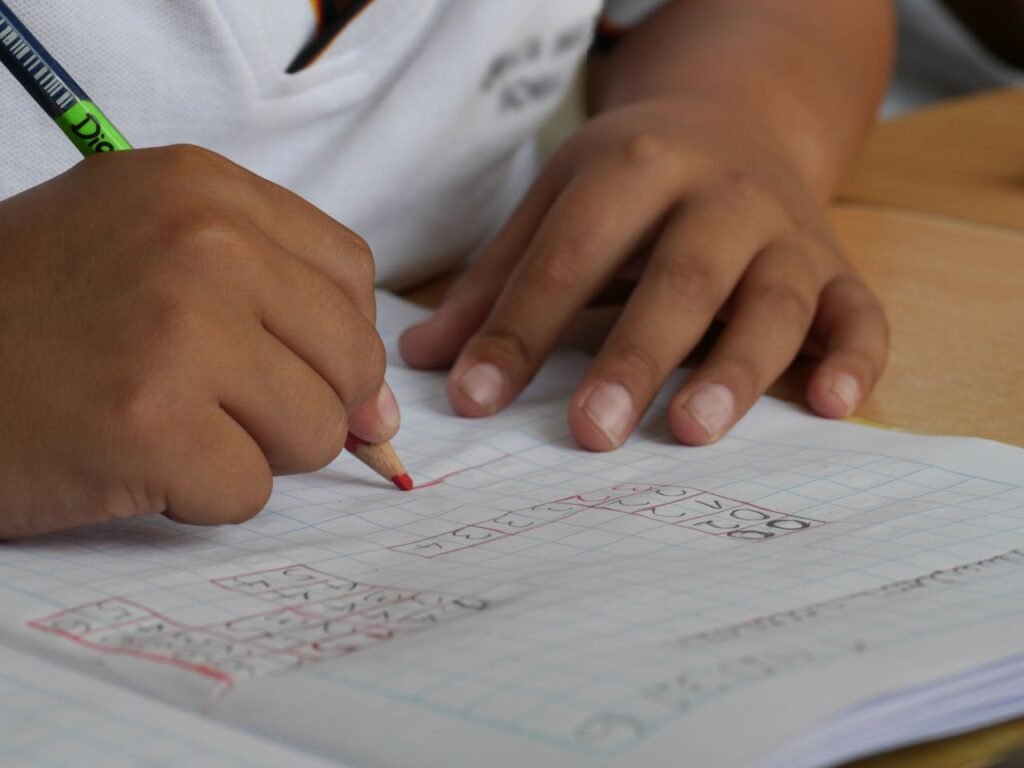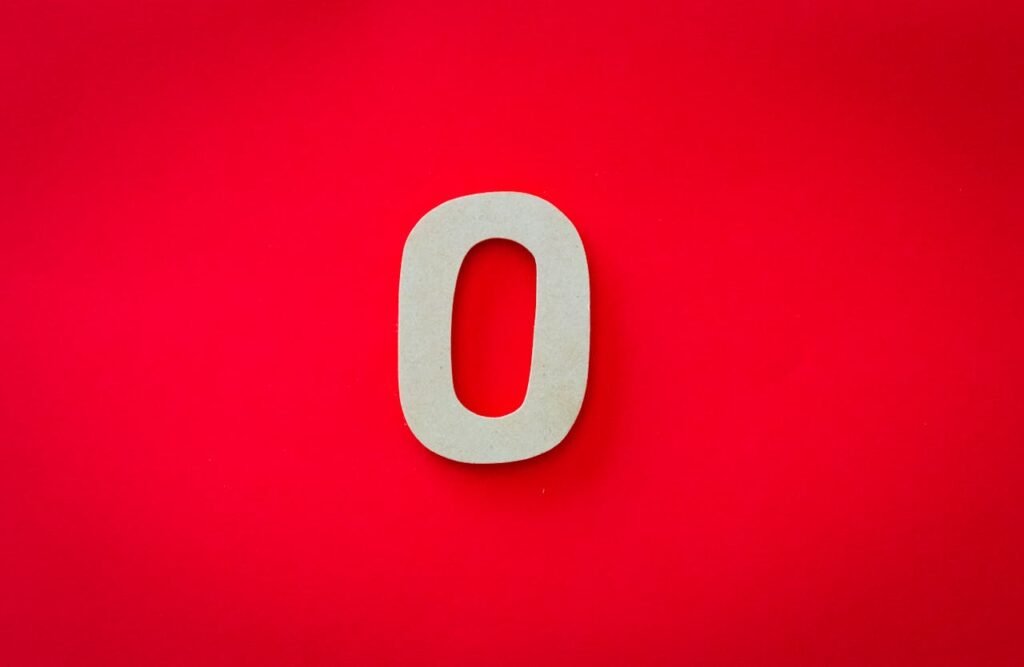For many kids, the word fraction brings one feeling—confusion. What does ¾ even mean? Why are we cutting things into pieces? And how do we know which piece is bigger?
If your child has ever looked at a fraction and said, “I don’t get it,” you’re not alone. This is one of the most common topics kids struggle with in math. But here’s the good news—it doesn’t have to stay that way.
At Debsie, we’ve seen kids go from scared to smiling just by learning to see fractions the right way. When we use pictures, shapes, and simple tricks that children can visualize, everything begins to make sense. Fractions are no longer just numbers. They become real things you can picture, draw, and even cut out with your hands.
What Are Fractions? Think of Pizza
Let’s begin with something every kid loves—pizza. Imagine you have a whole pizza, and you cut it into 4 equal slices. You take 1 slice and eat it.
You just ate 1 out of 4 slices. In math, we write that as ¼.
That little number is a fraction. And it’s telling a story:
- The bottom number (4) tells you how many equal parts the whole was cut into.
- The top number (1) tells you how many of those parts you have, or ate, or used.
So, ¼ means one part out of four total parts.
Simple, right?
If you eat another slice, now you’ve had 2 out of 4. That’s 2⁄4.
And guess what? If you eat all four slices, that’s 4⁄4—which is the same as one whole.
So now we know: fractions are just pieces of a whole.
Why Pictures Help So Much
Now imagine trying to learn that by just reading numbers. Boring. Confusing. But when we see it—like slices of a pizza, pieces of a chocolate bar, or chunks of an apple—it suddenly makes sense.
That’s why at Debsie, we always start with visuals when we teach fractions. We draw circles. We shade parts. We fold paper. We make it real.
When kids see a fraction, they stop guessing. They start understanding. The numbers are no longer scary—they’re just labels for parts of a picture.
It’s the same reason we use clocks to teach time or coins to teach money. When you connect math to the real world, kids click with it much faster.
Try This At Home: Draw Your Own Fractions
Grab a piece of paper. Draw a circle. Divide it into 4 equal parts. Shade in one part. That’s ¼.
Now draw another circle. Divide it into 2 parts. Shade one. That’s ½.
Do it again with 3 parts. Shade one. That’s ⅓.
By drawing, kids get to feel what the numbers mean. It’s not just a symbol. It’s a shape. A part. A piece.
These small drawings help children understand that fractions are not separate from whole numbers—they’re just smaller parts of a whole.
And once this idea is clear, everything else starts to fall into place.
Which Fraction Is Bigger? Use Your Eyes, Not Just Numbers

Here’s where many kids get confused: they see ½ and ¼, and they think, “Well, 4 is bigger than 2, so ¼ must be more than ½.”
But that’s not true. And that’s why we use pictures.
Let’s go back to our pizza. Imagine cutting one pizza into 2 slices. You take 1 slice—that’s ½ of the pizza.
Now imagine another pizza. This one is cut into 4 slices. You take 1 slice—that’s ¼.
Which piece is bigger?
It’s the half. Always. Because the fewer cuts you make, the bigger each piece is.
So even though the number 4 is bigger than 2, the fraction ¼ is smaller than ½.
And this is something we can’t always “see” with just numbers. But when we draw it, or cut a paper plate in half and then into fourths, it becomes super clear.
Try It With Paper and Scissors
If your child is still unsure, grab a round piece of paper—like a napkin or paper plate. Fold it in half. Open it. “This is one half,” you say.
Now fold it again to make fourths. Open it again. Now you can compare.
Ask: “Which piece looks bigger—the half or the fourth?” Let your child point, touch, and explain. That hands-on moment is where learning happens.
This little exercise helps children stop trusting just what the numbers look like—and start trusting what the parts really mean.
At Debsie, we do this kind of practice in live classes all the time. It gives children a chance to feel the math, not just memorize it.
Visual Comparison Builds Real Confidence
Once a child sees that 1 out of 2 is more than 1 out of 4, they begin to make better choices when comparing fractions.
From there, we can go to more examples:
“Which is more: ⅓ or ⅕?”
“Which is more: ¾ or ⅔?”
And we always go back to the drawing or the folding to help the idea stick.
It’s not about teaching “rules.” It’s about helping their brain see the difference.
With enough practice, children no longer have to draw every time—they just picture it in their heads. That’s when the magic happens. They’re thinking like real mathematicians.
Understanding Equivalent Fractions Without the Confusion
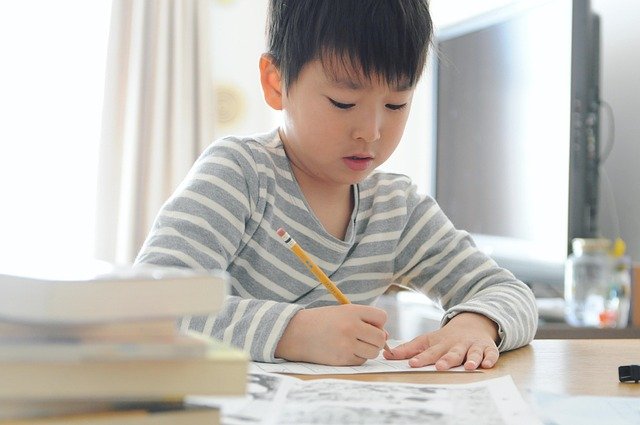
“Equivalent” is just a fancy word that means “equal” or “the same.” So when we say equivalent fractions, we’re talking about two different-looking fractions that are actually the same size.
Let’s go back to our pizza one more time.
Imagine you have a pizza, and you cut it into two equal pieces. You eat one piece. That’s ½.
Now imagine you cut the same size pizza into four equal pieces, and you eat two of them. That’s 2⁄4.
You ate the same amount of pizza in both cases, right? Half a pizza. But the numbers look different: ½ and 2⁄4.
That’s the secret of equivalent fractions. ½ = 2⁄4 because they represent the same part of the whole.
Use Drawing to “See” That They’re Equal
Now, draw two same-sized rectangles.
In the first one, divide it into 2 equal parts. Shade one. That’s ½.
In the second rectangle, divide it into 4 equal parts. Shade two. That’s 2⁄4.
Now compare them side by side. What do you notice?
They’re the same amount of shading. The same size. The same space. Just sliced differently.
This is where children have their “aha” moment. They finally see that changing the number of pieces doesn’t change how much you actually have—as long as you take the right number of parts.
We repeat this kind of visual trick at Debsie, over and over, using circles, bars, blocks—even real-life objects like paper strips or Lego bricks.
When kids practice with different shapes and still get the same answer, their brain starts to trust it: “Oh, this really is the same.”
How This Helps With Fractions Later On
Understanding equivalent fractions is not just a neat trick—it’s a big deal in math.
Later, kids will need this idea to:
- Add fractions with different denominators
- Simplify fractions
- Compare and order fractions
- Solve word problems
But instead of jumping into all of that at once, we first help children feel really comfortable seeing when two fractions are the same—even if they look different.
Once they believe it visually, they’re ready to do it with numbers.
That’s why we say: show it first, solve it second.
Let the child’s eyes teach their brain what “equal” looks like. Then the numbers make sense.
Adding and Subtracting Fractions—The Visual Way
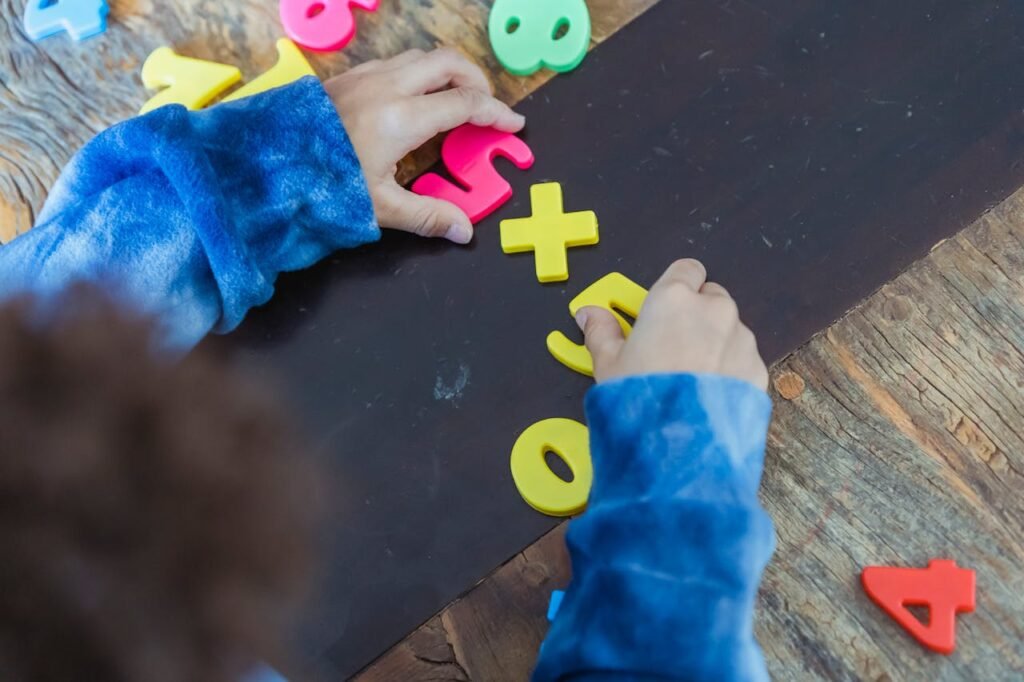
Don’t Start With Numbers—Start With Shapes
Here’s the mistake most people make when teaching kids to add or subtract fractions: they go straight to numbers. They show something like ⅓ + ¼, and the child has no idea where to start.
At Debsie, we always go backwards first. We start with shapes, not numbers. Because shapes don’t lie. Shapes help the child see what’s happening before they try to calculate anything.
Let’s try an easy one. Draw a rectangle. Divide it into 4 equal parts. Shade 1. That’s ¼.
Now draw the same kind of rectangle below it. Divide it into 4 equal parts again. Shade 2 parts. That’s 2⁄4.
Now ask: If we put the shaded parts together, how many do we have?
One part from the first shape, two parts from the second—3 parts out of 4. That’s ¼ + 2⁄4 = 3⁄4.
Simple. And it makes sense because we saw it happen.
This trick works even better when you’re using the same denominator. That means the shapes are already split into the same number of pieces, and you’re just counting the shaded parts.
That’s how addition of fractions starts to feel normal. Not scary. Not random. Just counting shaded pieces of the same shape.
What About Subtraction?
The same trick works for subtraction. Let’s say you draw a rectangle split into 4 equal parts and shade all 4—that’s the whole thing: 4⁄4.
Now you erase or cross out one shaded part. What do you have left?
3 parts out of 4, or 3⁄4.
So we just did 4⁄4 – ¼ = 3⁄4.
This works because children aren’t trying to “figure it out” in their heads—they’re watching it happen. That feeling of clarity is what we aim for in every Debsie lesson.
Children start to feel that they understand the math, not just follow it.
Slowly Move From Pictures to Numbers
Once your child can add and subtract fractions by using pictures, you can begin to move into the numbers.
We explain, gently, that all the shaded pieces were out of the same whole—so we could just add or subtract the top numbers.
¼ + 2⁄4 = 3⁄4
4⁄4 – ¼ = 3⁄4
No tricks. No guesswork. Just numbers that match what they already saw with their eyes.
The key here is trust—when a child trusts what they’re doing, they stop fearing fractions. And when they stop fearing them, they start solving them with ease.
Different Denominators? No Problem With Visual Help
Adding or subtracting fractions with different denominators is where many kids hit a wall. They see something like ½ + ⅓ and immediately get stuck.
It’s not because they can’t add—it’s because they’re trying to add pieces that don’t match. It’s like trying to stack puzzle pieces from two different puzzles. They just won’t fit.
But here’s the thing—we can fix this problem using visuals.
At Debsie, we show kids how to make the pieces match before they try to add. We draw two shapes, cut into different-sized parts, and show how we can change them to have the same number of equal parts—so we can finally add or subtract them easily.
Let’s walk through that.
Show, Don’t Just Say: Finding the Same-Sized Pieces
Take two same-sized rectangles.
In one, divide it into 2 equal parts. Shade one. That’s ½.
In the other, divide it into 3 equal parts. Shade one. That’s ⅓.
Now place them side by side. You’ll notice something: the pieces aren’t the same size. You can’t add them yet. They’re not speaking the same “math language.”
Now here comes the visual trick: split both shapes into 6 equal parts instead.
We guide the child step by step:
- If you cut each of the halves in the first rectangle into 3 pieces, you now have 6 smaller parts. That makes the original ½ equal to 3⁄6.
- If you cut each of the thirds in the second rectangle into 2 pieces, you also get 6 smaller parts. That makes ⅓ equal to 2⁄6.
Now both shapes are speaking the same language—sixths!
Now we ask: What’s 3⁄6 + 2⁄6? That’s 5⁄6. And we solved it by seeing it first.
When we do this in class, kids often say, “Ohhh! That makes sense now!”
They stop trying to memorize the rule about “finding the lowest common denominator” and start seeing what it means. They realize we’re just cutting the shapes into the same number of parts so we can work with them easily.
That one visual idea changes everything.
Practice Builds Confidence—and Speed
Once children get the hang of this idea visually, they start to apply it more quickly. They move from drawings to numbers naturally. Now, when they see ½ + ⅓, they already know: “Oh, I need to change them both to sixths.”
That’s the power of visual learning—it teaches the brain what to do before the child even sees the rule in a book.
At Debsie, we use this kind of teaching every day. We turn big, scary-looking problems into small, simple ones by helping kids see what’s really going on. And once they get it, they own it forever.
Making Fractions Real—Why They Actually Matter
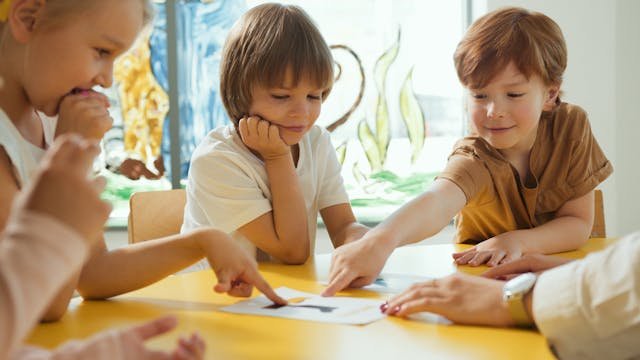
Kids often ask, “Why do I need to learn fractions?” And honestly, it’s a great question.
The answer is simple: fractions are part of everyday life. From slicing fruit to sharing toys, from baking cookies to telling time—fractions are all around us.
But children don’t always notice them, because no one points them out. That’s why, at Debsie, we build word problems, stories, and games that tie fractions into everyday situations. We want kids to feel that fractions matter—not just in math class, but in the world around them.
When kids realize they’re already using fractions without knowing it, they stop resisting and start engaging.
Think About Food, Time, and Sharing
Let’s say your child is cutting a sandwich in half. One piece is eaten. The other is shared with a friend. That’s ½, split again into ¼ each. And just like that, they’ve practiced dividing a whole into equal parts.
Or maybe they’re helping you bake cookies. The recipe says to use ¾ of a cup of milk. You only have a ¼ measuring cup. Now it becomes a real-life problem to solve: “How many ¼ cups do we need to get to ¾?” (Answer: 3!)
Even something like watching the clock involves fractions. When the minute hand is on the 3, it’s been ¼ of an hour. On the 6? Half an hour. On the 9? ¾ of an hour.
These little moments are filled with fractional thinking. They’re not word problems in a textbook—they’re real. And when kids connect math to their world, it sticks in a whole new way.
From Frustration to Fun
When a child sees fractions as a tool to solve real problems, something amazing happens. They stop being scared of the numbers. They start using them. Playing with them. Exploring them.
At Debsie, we design every lesson to feel like that kind of discovery. Not a chore. Not a lecture. But a friendly conversation that slowly turns confusion into clarity.
We’ve watched children who once froze at the sight of ⅔ + ½ begin to solve real-life fraction puzzles with excitement—just because they saw why it mattered.
This shift—from fear to fun—is what makes learning powerful.
And the best part? Once your child gets fractions, everything that comes later in math (like decimals, percentages, ratios, and even algebra) becomes much, much easier. Because fractions are the foundation.
How Debsie Makes Fractions Click (For Real)

We Start With Visuals—Always
At Debsie, we don’t throw numbers at kids and hope they catch on. We start where it makes the most sense—with pictures, drawings, and real-life examples. We help children see the math before we ask them to solve anything.
In every fraction lesson, our expert teachers use visual tools like shaded circles, paper folds, food models, and even screen-based games to make sure children understand what’s happening.
Because when a child sees what ½ or ⅓ or ¾ really looks like, they don’t need to memorize—they just get it. That’s how real learning happens.
Personalized Support for Every Child
Every child learns differently. Some need more time. Some need more examples. Some need encouragement to even try.
That’s why Debsie classes are small, focused, and full of patient, caring teachers who meet each child where they are.
If a child struggles with comparing fractions, we slow down and practice. If they’re flying ahead, we stretch them with challenges. Either way, every child is seen, heard, and supported all the way through.
We also know that fractions are not just a math skill—they’re tied to reading, comprehension, problem-solving, and confidence. So we focus on building the whole learner, not just teaching formulas.
Learning That Feels Like Play, But Goes Deep
Children at Debsie don’t sit through boring lectures. They interact. They explore. They ask questions. They draw. They move. They build. They play with numbers the way kids play with toys—curious and full of imagination.
And while it may feel like play, it’s actually powerful, structured learning. Our programs are carefully designed to follow global standards, but taught in a way that feels natural and exciting to children.
From ages 5 to 18, we help kids grow from “I don’t get fractions” to “I love solving them”—and we make sure the learning sticks.
Conclusion
Fractions don’t have to be scary. They don’t have to be confusing. And your child doesn’t have to feel stuck.
With the right tools, the right pace, and the right teacher, every child can understand fractions deeply. Not just for a test. But for life.
At Debsie, we believe that every child deserves to feel smart, capable, and proud of their learning. We make that happen with clear visual teaching, gentle support, and fun lessons that actually make sense.
So if your child is struggling with fractions, don’t worry. The solution isn’t more pressure—it’s more clarity. More care. More Debsie.
🧠 Ready to help your child turn confusion into confidence?
🎓 Try a free class with Debsie today—and watch fractions finally click.
Because every child can learn. They just need to be taught the right way.
Read Next:

